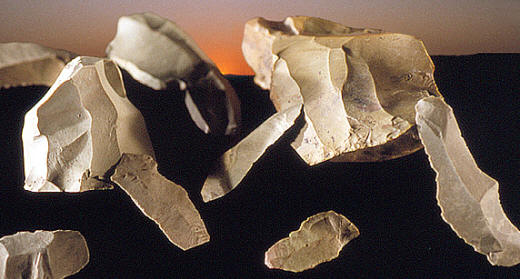|
"Fourteen years
of excavation yielded little else but flaked stone tools, debitage from
their manufacture and maintenance, a lesser number of rough stone tools,
stones showing abrasion resulting from use and a small volume of
potshards of the post-Dalton era."---2002,
Richard Michael Gramly, "Olive Branch: A Very Early Archaic Site On
The Mississippi River," p. 115.
"The
group of analyzed specimens from Olive Branch includes the largest,
systematically excavated Dalton tool assemblage from any open site."---2002,
Richard Michael Gramly, "Olive Branch: A Very Early Archaic Site On
The Mississippi River," p. 116.
"----in short,
the dating evidence for Dalton is mixed with some researchers preferring
an "early chronology" of 10,000-10,500 years before present and other
opting for a more recent age of 9,000-10,000 years. The sheer weight of
the evidence favors placement within the tenth millennium before present"
---2002, Richard Michael Gramly, "Olive Branch: A Very Early
Archaic Site On The Mississippi River," pp. 219-220.

DALTON TOOLS
OLIVE BRANCH SITE
ALEXANDER
COUNTY, ILLINOIS
EARLY ARCHAIC PERIOD
The stone tools that Dalton people were making 10,000 years ago were
simple and primitive but they were effective. Their toolkit successfully
produced the intended results that the user needed for piercing,
drilling, scraping, breaking, smoothing and cutting processes. The fact
that they were successful is also proven by many other cultures, around
the world, who used similar tools for many thousands of years before and
after the Dalton culture.
The majority of all Dalton tools that have ever been recovered from
Early Archaic sites are made of stone. But many more tools were made of
organic materials that were not preserved. Dalton people made a variety
or different kinds of tools from antler and bone such as awls, atlatl
hooks, handles and needles. They have survived but in far lesser numbers
than artifacts made of stone.
|
|
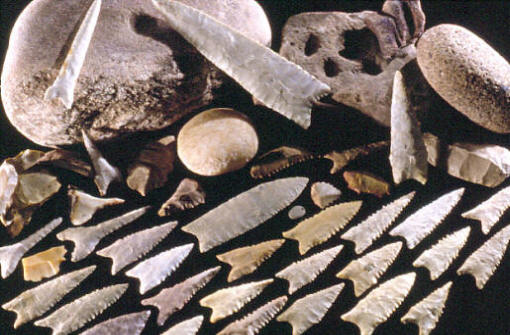
DALTON
TOOLS
OLIVE
BRANCH SITE
ALEXANDER
COUNTY, ILLINOIS
EARLY ARCHAIC
PRIVATE
COLLECTIONS
This picture shows a wide variety of Dalton tools from the Olive
Branch site in southern Illinois. The most diagnostic or
recognizable examples are the projectile points. Dalton people made
many different styles of projectile points and knives. It's obvious
that the smaller points were being propelled through the air because
many of of them have impact fractures. Most of the tools from Olive
Branch are in the form of simple tools made on flakes. Some of the
heavier tools are represented by Adzes, hammer stones, anvil stones
and abraders. |
|
|
Most Dalton tools were made from simple flakes.
Utilized flakes represent the largest number. These were flakes that were not altered in any way except for obvious use wear along the
edges from cutting. Other flakes were reshaped along the edges by
pressure flaking to form the various types of end-scrapers,
side-scrapers, gravers, denticulates and drills. More complicated
bifacially flaked tools like projectile points and knives were made from
thicker flakes. |
|
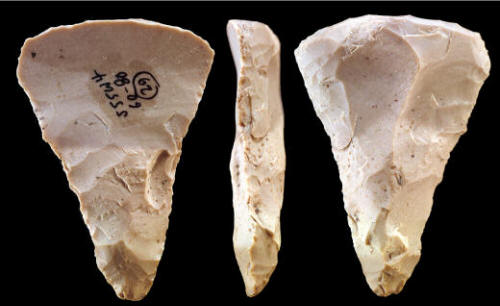
CLICK ON
PICTURE FOR LARGE TRIPLE IMAGE
DALTON END-SCRAPER
OLIVE
BRANCH SITE
ALEXANDER
COUNTY, ILLINOIS
EARLY ARCHAIC
PRIVATE
COLLECTION
Large numbers of end-scrapers were found at Olive Branch.
End-scrapers were also one of the most commonly used tool forms on
Clovis sites across North America, so they have a long history as a
popular tool form. The example pictured here is typical. It's made
from a flake that has been pressure flaked into a triangular shape
with a wide scrapping edge on one end and a narrower point on the
other. This type of scraper was most probably hafted onto a short
handle the same way Eskimo and Mandan end-scrapers were hafted. |
|
|
The basic technique for Dalton stone tool
manufacturing is core and blade technology. This process produces simple
flakes in large numbers in an efficient manner by preparing striking
platforms on a core and striking off a flake. Core and blade technology
was invented in Europe
during the Aurignacian period
approximately 34,000 years ago.
One of the most common tools found on Dalton sites are
end-scrapers. These tools are generally thick and heavy duty but some
were made on thin flakes. Gramly writes, "Dalton end-scrapers tend to
have rounded bits but become more angular when approaching exhaustion."
These tools were probably hafted on the ends of a short handles. Hafted
end-scrapers with handles have been observed on Eskimo and Mandan sites.
End-scrapers are a popular tool form that has been found on prehistoric sites around the world. The
earliest recognized culture in North America, the Clovis culture, also
produced large numbers of end-scrapers. |
|
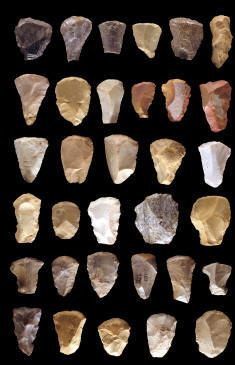 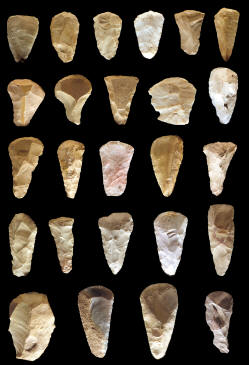
CLICK ON EACH PICTURE FOR LARGER IMAGE
DALTON END-SCRAPERS
OLIVE
BRANCH SITE
ALEXANDER
COUNTY, ILLINOIS
EARLY ARCHAIC
PRIVATE
COLLECTION
These 58 end-scrapers illustrate a few of the examples found on the
Olive Branch site. They show the generally triangular outline of a
wider end for the scraping edge and a narrower end where it was
hafted. As the rounded working edges were resharpened they become
more straight. |
|
|
Another common tool
form are side-scrapers. The Olive Branch site produced four different forms
of side-scrapers. The most common form are side-scrapers with only one
scraping edge. Another form has one scraping edge with only slight use
wear on the opposite edge. A third form is represented by side-scrappers that have two
working edges that converge to a point. The fourth type found on the
Olive Branch site are side-scrapers that have two working edges that are
parallel to each other. |
|
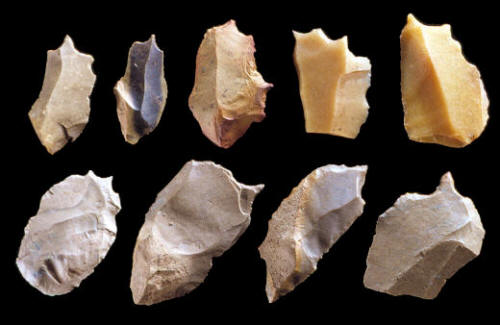
CLICK ON PICTURE FOR LARGER IMAGE
DALTON GRAVERS
OLIVE
BRANCH SITE
ALEXANDER
COUNTY, ILLINOIS
EARLY ARCHAIC
PRIVATE
COLLECTION
These Dalton gravers are typical examples. They all have one or more
small graver points that were formed by pressure flaking a notch on
either side of the point. Gramly writes that "Judging by their
abundance, gravers were an important component of the Dalton
toolkit, second only in importance, perhaps, to utilized flakes
(cutters). Flakes of all shapes and sizes as well as discarded tool
forms and fragments were retouched making one or more sharp spurs."
Gravers are fairly delicate tools that would have been used to
groove or cut organic materials such as leather, bone or wood. |
|
|
Another tool form that is commonly found on early
sites around the world, are
gravers. The Olive Branch site produced many "classic" examples. Gravers
were made on simple flakes by pressure flaking two notches along an edge
to isolate a small projecting point or spur. Some gravers have multiple
points along the edge. These tools were probably used to cut or groove various types of organic materials such as antler, bone or wood. |
|
CONTINUE ON TO PAGE
TWO
|
|
"REFERENCES"
1983, Morse, Dan F.
and Morse, Phyllis A., "Archaeology Of The Central Mississippi
Valley," p. 73.
2002, Gramly, Richard Michael "Olive
Branch: A Very Early Archaic Site On The Mississippi River," p. 116.
|
|
RECENT
LISTINGS HOME
ORDERING |
